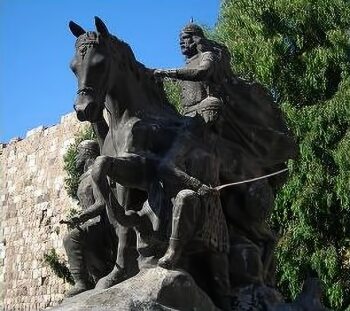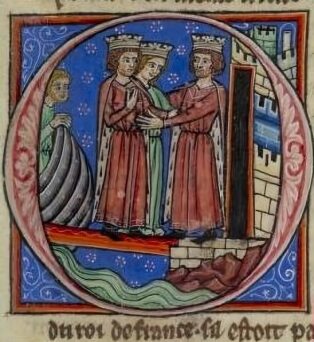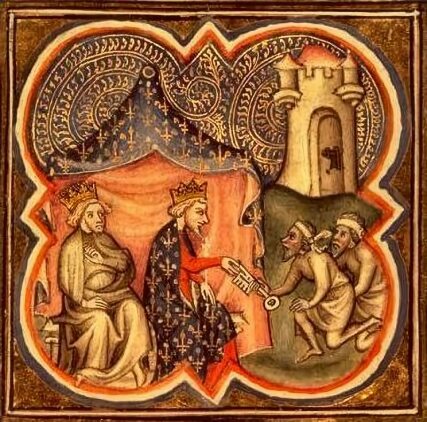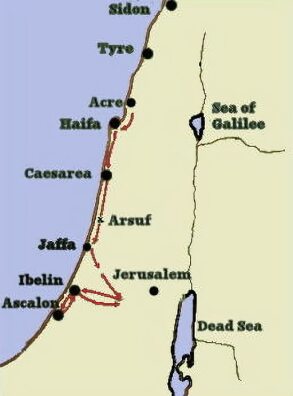1189-92. Background to the Crusade
News that shocked all Christendom arrived from the East in late 1187, the Kingdom of Jerusalem, established in 1099 during the First Crusade, had fallen to the Moslems.
Baldwin IV, the Frankish King of Jerusalem who inherited the kingdom in 1174, defeated Saladin in battle with the aid of Raynald of Châtillon, Prince of Antioch, at Montgisard in 1177. An agreement was reached between the king and Saladin permitting free trade between Christian and Moslem domains and peace was maintained. Raynald, however, continued raids on Moslem caravans, actions that engendered hatred between Christian and Moslem. The king suffered from leprosy and died in 1185. He was succeeded by his eight-year-old nephew, Baldwin V, the son of his sister, Sybilla. Baldwin V died the following year when Sybilla and her husband Guy de Lusignan ascended the throne.
Saladin
Raynald of Châtillon further provoked the Moslems by raiding a rich caravan and incarcerating its owners in his dungeon. Saladin demanded their release but Raynald refused. In response Saladin besieged Tiberias and Guy de Lusignan marched out to meet him. The two armies met at Hattin, where the Christian army suffered a crushing defeat. King Guy and Raynald de Châtillon were taken prisoner and in the aftermath of the battle Raynald de Châtillon was beheaded.
The Moslem army then advanced on Acre and Jerusalem. Balian of Ibelin, Lord of Nablus, defended the city, but it was finally surrendered to Saladin on 2nd October 1187. When Jerusalem was first taken by the armies of Christendom, its Moslem inhabitants had been massacred, the Moslem leader, Saladin or Al-Malik al Nasir Salah ed-Din Yusuf showed himself more merciful and generous, allowing the Christians within the city to leave unharmed and cleansed the holy places with rosewater. Christian priests were allowed to hold services at the Church of the Holy Sepulchre and the Jewish community was permitted to return to the city. At the close of 1187, but three coastal towns, Antioch, Tripoli and Tyre were all that remained in the hands of the Christians.
The call to arms
Pope Urban III was reported to have died of shock on receipt of the news of the fall of Jerusalem. His successor, Pope Gregory VIII appealed to the leaders of Christendom for aid. The first to respond to the papal appeal was King William II of Sicily sailed immediately for the East, although he perished in November 1189. In January 1188, Henry II of England, his son, Richard, then Duke of Aquitaine and Phillip II Augustus of France took the cross and made a solemn vow to recover the Holy City.
The septuagenarian Frederick Barbarossa, Holy Roman Emperor responded to the call, he raised a massive German force and embarked for the Holy Land in May of 1189. The German army met with some initial success taking Iconium in May 1190 but tragically, the ageing Frederick, who had ridden ahead with his bodyguard, was thrown from his horse whilst crossing the Saleph River in Cilicia and drowned. Many of the disheartened Germans returned and the emperor's son, Frederick of Swabia, led the remainder of the German contingent to Antioch, where they lost further men to an outbreak of fever, before continuing to Acre.
Henry II of England died on 6th July 1189, whilst in conflict with his eldest surviving son, Richard the Lionheart and Phillip Augustus of France. Having succeeded to his father's dominions, Richard of England and Philip of France embarked for the Holy Land in July 1190, sailing from Marseille. The two kings who set out together to win back the Holy City represented very different personalities. Richard of England, committed, generous and noble, was possessed of a fearful temper and could be violent to any who opposed him. He was a brilliant general but had little administrative ability. Philip II of France was a scheming and unscrupulous politician, but a reluctant crusader whose real interests lay in the expansion of his domains.
Richard I and Philip Augustus
Sicily
The crusaders stopped en-route at Sicily, where Richard's sister, Joanna, the dowager Queen, was being held captive by her nephew, Tancred, the new King, who was also steadfastly refusing to return her considerable dowry. Tancred became more amenable when Richard arrived on the scene and when he captured the city of Messina, Tancred was forced to release Joanna.
Phillip Augustus, outshone by his ally Richard, sulked. He raised the issue of his sister, Alys, who had been betrothed to Richard since childhood. Gossip claimed that Richard refused to marry Alys as she had been seduced by his father and was even rumoured to have borne the late king's child. The English King informed Phillip that he intended to marry the Princess Berengaria of Navarre, the daughter of Sancho VI of Navarre, whom his mother was escorted to Sicily. Richard and Berengaria had met only once prior to their espousal, at a tournament at Pamplona held by her father. There was little the slighted Phillip could do other than simmer.
Cyprus
The voyage to the Holy Land continued, but the ship carrying Berengaria and Joanna was wrecked on the coast of Cyprus in the course of a violent storm. The Cyprians besieged the English survivors of the wreck at Limassol. A large amount of treasure, intended for use on the crusade, was appropriated by Isaac Comnenus, the Emperor of Cyprus.
Richard dispatched a letter to Isaac, which was arrogantly ignored. Outraged, he unleashed the full force of the famed Plantagenet fury on the unfortunate Isaac, who discovered he had been unwise to underestimate the strength of the English king. The Cyprian Emperor was overthrown and English governors were set up over the island which was used as a garrison for the crusade. Cyprus proved to be a vital source of supplies throughout the Third Crusade and would remain a Christian outpost in the Middle East for the following four centuries.
Richard I and Philip Augustus
The Siege of Acre
King Guy of Jerusalem had been taken prisoner by Saladin after the disastrous Battle of Hattin, but had been ransomed in 1189. Undeterred in defeat, he gathered an army and laid siege to the city of Acre. Disease was rife in the crusader camp, Sybilla, Queen of Jerusalem, in whose right Guy acquired his claim to the throne, succumbed to the sickness and died, along with her daughters. The heir to Jerusalem's throne was now Sybilla's half-sister, Isabella, who was hastily divorced from her husband, Humphrey of Toron and married to Conrad of Montferrat, Phillip of France's cousin, who now lay claim to Jerusalem's throne. Guy de Lusignan, however, refused to abandon his claim.
Frederick of Swabia became a further victim of disease in the camp and command of the remainder of the German army was assumed by Duke Leopold V of Austria. Philip of France arrived at Acre with reinforcements in May, while the English contingent finally arrived in the Holy Land from Sicily at Whitsun, 1191.
Richard I's reputation seems to have travelled to the Holy Land before him, his arrival reinvigorated the siege and on 11th July, Moslem defenders surrendered the city to the Christian army in violation of the orders of Saladin. The city walls were breached early in July and on the 11th July, its garrison offered their terms of surrender. They agreed to surrender two thousand prisoners, to pay two hundred thousand gold pieces and to return the True Cross, a venerated Christian relic.
Richard, Philip, and Leopold V of Austria disagreed over the distribution of the spoils of their victory. Richard deeply insulted Leopold when he threw down his standard from the walls of Acre, an action that was to have dire consequences for him in the future. A further cause of dissension among the leaders of the crusade was Richard's support of Guy de Lusignan, King of Jerusalem, while Philip Augustus and Leopold supported his rival for the title, Conrad of Montferrat.
King Phillip Augustus of France was anxious to return home, he did not enjoy being eclipsed by Richard, his health had suffered and he was piqued at the repudiation of his sister. He set sail for France on the 3rd of August, abandoning the crusade but left behind a large portion of his army and funds to pay them, leaving Richard the sole leader of the Third Crusade.
An exchange of prisoners from Acre was arranged with Saladin, but problems arose. Richard believed Saladin to be creating delays. He consequently ordered the massacre of all the Moslem prisoners. Two thousand seven hundred prisoners were executed outside the walls of Acre. They were killed within sight of Saladin's army who made attempts at rescue but were driven back. This act of cruelty remains a bloody stain on Richard's reputation.
The Batle of Arsuf
On 7th September, 1191, at Arsuf, the armies of Richard and Saladin clashed in battle. Richard's outnumbered army rose at first light in attempt to seize Arsuf. The Crusaders formed their army, estimated at around 1, 200 horse and 10,000 foot in three columns. Saladin commanded about 20,000 men, which included 10,000 cavalry.
The Holy Land
Richard at first progressed towards Arsuf unhindered, at about 11 a.m., Saladin's cavalry began to launch attacks on the Crusading army's left flank. Richard endeavoured to keep the army moving forward and maintain formation, but as the afternoon progressed, the terrible heat and growing casualties led the Knights Hospitallers and several squadrons of French knights to charge the Moslems, who drove back the Moslem right wing. Richard reacted quickly to this breach of orders and ordered the Knights Templar, the Bretons and Angevins to advance in a further charge that repelled Saladin's left-wing.
Richard's military brilliance had prevailed, forcing the Moslems, who sustained heavy losses, estimated at around 7,000, which included 32 emirs, into retreat, the Crusaders suffered only slight casualties. Saladin, his prestige having suffered a terrible blow, was never again to risk open battle with Richard. The Crusader army proceeded to Jaffa and began to strengthen it as a garrison for Jerusalem. He went on to re-establish Christian control of the coast and refortified Ascalon to the south. The army arrived at the foothills of the Holy City on 3rd January 1192. They were, however, exhausted, short of supplies and sickness was rife in their ranks, they were consequently obliged to return to the safety of the coast.
Negotiations
A truce was negotiated with the Moslems. A superlative general but a poor politician, Richard proposed that Saladin should give the Holy Land to his nephew Saphadin, whom he suggested should marry his sister Joanna, forming a peaceful alliance between Christian and Moslem. The bemused Saladin, unable to believe his luck, accepted. Joanna, however, possessed the famed Plantagenet temper in full measure and refused outright to contemplate marriage with a Moslem, resulting in a heated family dispute.
Richard made attempts to negotiate with Conrad of Montferrat, but Conrad, who distrusted him due to his support of Guy de Lusignan, refused. Following an election of the nobles of the kingdom in April, Conrad was unanimously voted as King of Jerusalem, however, before his coronation could take place he was murdered at Tyre by two Hashshashin. Conrad held his claim to the throne through his marriage to the heiress Isabella of Jerusalem, who just over a week later was married to Henry II of Champagne, the nephew of both Richard and Phillip, (through Eleanor of Aquitaine's first marriage to Louis of France). Rumours circulated that Richard had had some involvement in Conrad's murder. Guy of Lusignan retired to Cyprus, which his descendants were to rule for the next two hundred years.
Richard received disquieting news from England, his younger brother John, in league with Phillip Augustus, was plotting against him to take the throne of England. He made a further approach to Jerusalem but again realised he could not take the city and that he must now urgently return home. Without control of the hinterland, Richard realised he could not hold the Holy City for any length of time. Heartened, Saladin then re-took Jaffa. On hearing the news, Richard set sail for the city with eighty knights, four hundred bowmen, and around two thousand Italian soldiers, arriving at Jaffa 31st July, he charged into the city in a daring surprise attack. The Muslims panicked and fled, causing Saladin to lose control of his troops.
Having signed a three-year truce on 2nd September 1192, which retained his conquests and gave Christians access to Jerusalem, Richard the Lionheart left the Holy Land and sailed for England.
Richard's Capture
On his return journey to England, Richard was shipwrecked near Aquilaea, adopting the dress of a Templar knight as a disguise, he attempted to cross the Alps into Saxony. On 11th December he had the ill fortune to be recognized and captured at an inn near Vienna, in the territory of Leopold of Austria, whom he had gravely insulted at Acre. He reluctantly yielded Richard to his overlord, Henry VI, the Holy Roman Emperor, who demanded the English pay a huge ransom for the return of their king. Richard was finally released on payment of the first instalment of the ransom in March 1194.
Berengaria of Navarre PreviousNext Joanna, Queen of Sicily
